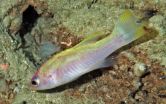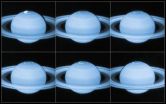(Press-News.org) Smithsonian scientists describe a colorful new species of small coral reef sea bass from depths of 182–241 m off Curaçao, southern Caribbean. With predominantly yellow body and fins, the new species, Liopropoma santi, closely resembles the other two "golden basses" found together with it at Curaçao: L. aberrans and L. olneyi.
The scientists originally thought there was a single species of golden bass on deep reefs off Curaçao, but DNA data, distinct color patterns, and morphology revealed three. The study describing one of those, L. santi—the deepest known species of Liopropoma in the Atlantic Ocean, was published in the open access journal ZooKeys.
Dr. Carole C. Baldwin and Dr. D. Ross Robertson, who discovered the new species, propose the common name "spot-tail golden bass" to distinguish it from the other golden bass species, referencing the dark spot on the lower part of the tail fin. It appears to be more closely related to the other new deep-reef golden bass from Curaçao, Liopropoma olneyi, and members of a related genus, Bathyanthias, than to species of Liopropoma such as the candy and peppermint basses inhabiting shallower reefs.
"With Bathyanthias falling out within the western Atlantic Liopropoma clade," notes Baldwin, "further study of the classification of this group is needed." The researchers also note that related groups of Liopropoma species have different depth distributions, suggesting that depth may have played a role in their evolution.
To collect deep-reef fish specimens, the scientists are diving to 300 m off Curaçao using a manned submersible, the Curasub. "This underexplored zone between 60 and 300 m in the tropical southern Caribbean is revealing extraordinary biodiversity, including a wealth of new species of beautifully colored fishes," says Baldwin. "It's a zone that science has largely missed because it's too deep to access using scuba gear, and deep-diving submersibles rarely stop at such shallow depths."
INFORMATION:
As part of the Smithsonian Institution's Deep Reef Observation Project (DROP), Smithsonian scientists are working to improve our knowledge of Caribbean deep-reef biodiversity.
Original Source:
Baldwin CC, Robertson RD (2014) A new Liopropoma sea bass (Serranidae, Epinephelinae, Liopropomini) from deep reefs off Curaçao, southern Caribbean, with comments on depth distributions of western Atlantic liopropomins. ZooKeys 409: 71–92. doi: 10.3897/zookeys.409.7249
The spot-tail golden bass: A new fish species from deep reefs of the southern Caribbean
2014-05-19
ELSE PRESS RELEASES FROM THIS DATE:
Neutron beams reveal how antibodies cluster in solution
2014-05-19
Scientists have used small-angle neutron scattering (SANS) and neutron spin-echo (NSE) techniques for the first time to understand how monoclonal antibodies (mAbs), a class of targeted biopharmaceuticals used to treat autoimmune disorders and cancer, dynamically cluster and move in high concentration solutions. Certain mAb cluster arrangements can thicken pharmaceutical solutions; they could thus limit the feasible concentration of injectables administered to patients around the world. The insights provided by a team of neutron scientists from the National Center of Neutron ...
San Diego county fires still rage
2014-05-19
The San Diego County fires that began on Wednesday May 14 as a single fire that erupted into nine fires that burned out of control for days. According to News Channel 8, the ABC affiliate in San Diego, the following summarizes what the current conditions are for the fires still left burning:
"Cocos Fire - San Marcos: This fire has burned 1,995 acres and is 87 percent contained Monday morning. All evacuation orders and road closures were lifted as of 11 a.m. Sunday, according to the City of San Marcos.
San Mateo Fire - Camp Pendleton: The San Mateo Fire that was reported ...
New technique to prevent anal sphincter lesions due to episiotomy during child delivery
2014-05-19
Results of a 10-year long multinational research project on Technologies for Anal Sphincter analysis and Incontinence (TASI) are available in:
Corrado Cescon, Diego Riva , Vita Začesta, Kristina Drusany-Starič, Konstantinos Martsidis,
Olexander Protsepko, Kaven Baessler, Roberto Merletti
Effect of vaginal delivery on the external anal sphincter muscle innervation pattern evaluated by multichannel surface EMG: results of the multicentre study TASI-2
International Urogynecology Journal, DOI 10.1007/s00192-014-2375-0.
Episiotomy is a controversial surgical ...
Studies published in NEJM identify promising drug therapies for fatal lung disease
2014-05-19
LOS ANGELES (May 18, 2014) – Researchers in separate clinical trials found two drugs slow the progression of idiopathic pulmonary fibrosis, a fatal lung disease with no effective treatment or cure, and for which there is currently no therapy approved by the Food and Drug Administration.
Paul W. Noble, MD, chair of the Department of Medicine at Cedars-Sinai and director of the Women's Guild Lung Institute, is the senior author of the multicenter study that found that the investigational drug pirfenidone significantly slowed the loss of lung function and reduced the ...
EPA ToxCast data validates BioMAP® systems' ability to predict drug, chemical toxicities
2014-05-19
FREMONT, CA (May 19, 2014): Newly published research demonstrates the ability of BioMAP® Systems, a unique set of primary human cell and co-culture assays that model human disease and pathway biology, to identify important safety aspects of drugs and chemicals more efficiently and accurately than can be achieved by animal testing. Data from BioMAP Systems analysis of 776 environmental chemicals, including reference pharmaceuticals and failed drugs, on their ability to disrupt physiologically important human biological pathways were published online this week in Nature ...
Fluoridating water does not lower IQ: New Zealand research
2014-05-19
New research out of New Zealand's world-renowned Dunedin Multidisciplinary Study does not support claims that fluoridating water adversely affects children's mental development and adult IQ.
The researchers were testing the contentious claim that exposure to levels of fluoride used in community water fluoridation is toxic to the developing brain and can cause IQ deficits. Their findings are newly published in the highly respected American Journal of Public Health.
The Dunedin Study has followed nearly all aspects of the health and development of around 1000 people born ...
Chinese scientists crack the genome of another diploid cotton Gossypium arboreum
2014-05-19
Shenzhen, May 18, 2014---Chinese scientists from Chinese Academy of Agricultural Sciences and BGI successfully deciphered the genome sequence of another diploid cotton-- Gossypium arboreum (AA) after the completed sequencing of G. raimondii (DD) in 2012. G. arboreum, a cultivated cotton, is a putative contributor for the A subgenome of cotton. Its completed genome will play a vital contribution to the future molecular breeding and genetic improvement of cotton and its close relatives. The latest study today was published online in Nature Genetics.
As one of the most ...
The young sperm, poised for greatness
2014-05-19
SALT LAKE CITY— In the body, a skin cell will always be skin, and a heart cell will always be heart. But in the first hours of life, cells in the nascent embryo become totipotent: they have the incredible flexibility to mature into skin, heart, gut, or any type of cell.
It was long assumed that the joining of egg and sperm launched a dramatic change in how and which genes were expressed. Instead, new research shows that totipotency is a step-wise process, manifesting as early as in precursors to sperm, called adult germline stem cells (AGSCs), which reside in the testes. ...
'Smoking gun' evidence for theory that Saturn's collapsing magnetic tail causes auroras
2014-05-19
University of Leicester researchers have captured stunning images of Saturn's auroras as the planet's magnetic field is battered by charged particles from the Sun.
The team's findings provide a "smoking gun" for the theory that Saturn's auroral displays are often caused by the dramatic collapse of its "magnetic tail".
Just like comets, planets such as Saturn and the Earth have a "tail" – known as the magnetotail – that is made up of electrified gas from the Sun and flows out in the planet's wake.
When a particularly strong burst of particles from the Sun hits Saturn, ...
Solar energy prospects are bright for Scotland, experts say
2014-05-19
Installing state-of-the-art solar panels on a quarter of a million roofs could meet one-sixth of Scotland's electricity demands, experts say.
Scientists say the strategy could ease the plight of one in three Scottish households, which currently struggle to provide themselves with adequate heat and hot water.
Researchers, business leaders and public sector experts have contributed to a report which sets out how Scotland could benefit from solar power.
They say harnessing energy from the sun on the roofs of south-facing buildings could have significant economic, ...



